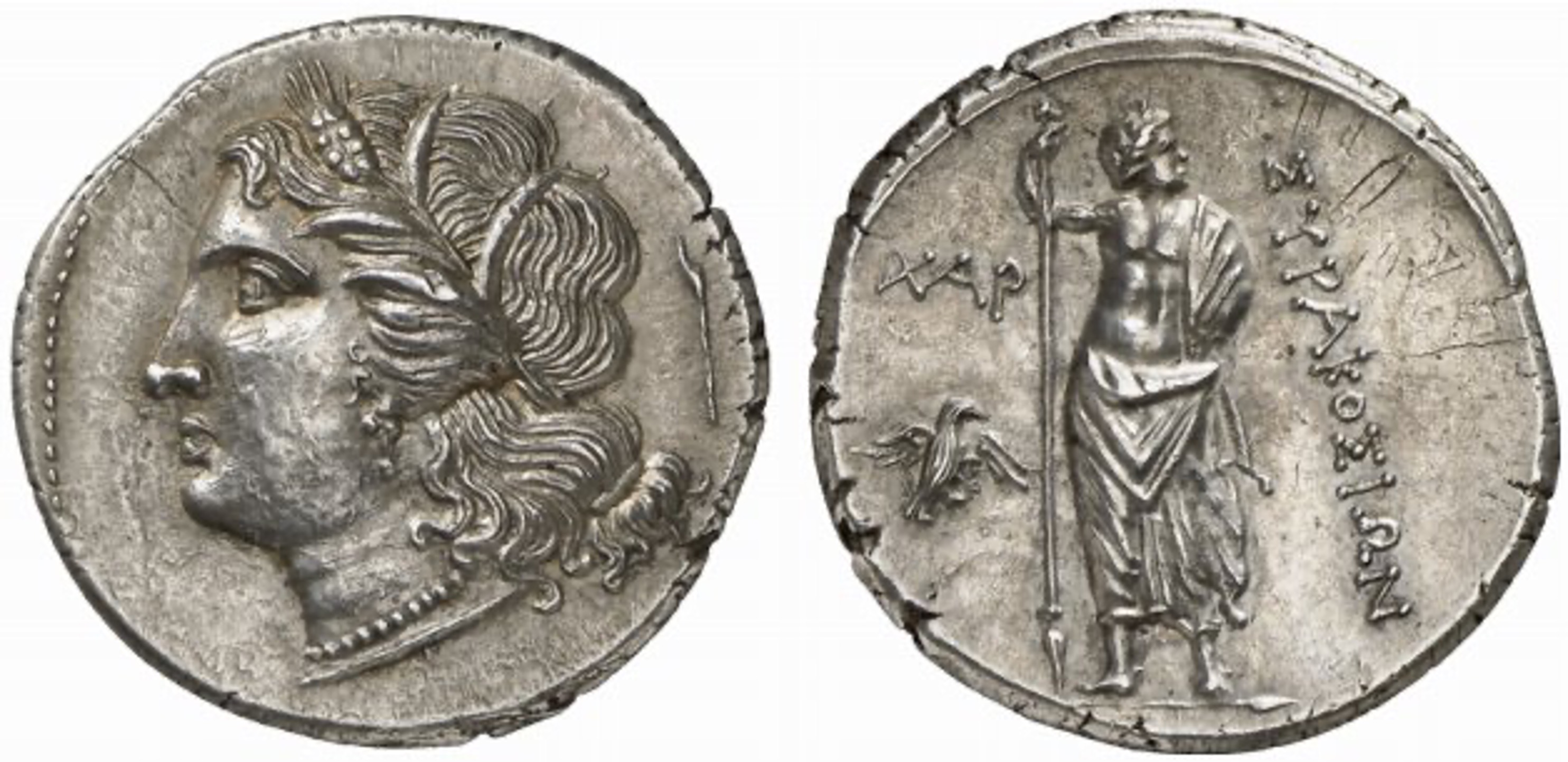214 BCE - 212 BCE | ΣYPAKOΣIΩN
Overstriking coin
SO_190_-_Syracuse_(10_litrai_Persephone-Zeus).jpg
[1]
|
|
Sale(s)Sale(s) ᵖ:
|
Künker, 143, 6 Oct. 2008, 105 ; Triton, 11, 08 Jan. 2008, 75.
|
|
|
|
Description
| ObverseInscription or printing placed on the obverse.:
|
Head of Persephone left, wearing earring, necklace and wreath of grain ears. In field, long torch. Border of dots.
|
ReverseInscription or printing placed on the reverse.:
|
ΣYPAKOΣIΩN (Greek) Zeus Strategos standing facing, head right, wearing himation, holding scepter. To left, XAP above eagle flying .
|
Mint and issuing power
| MintIdentifies the place of manufacture or issue of a numismatic object.:
|
Syracuse
|
Ancient regionAncient region.
|
Sicily
|
Modern countryModern country: Italy
|
AuthorityIdentifies the issuing power. The authority can be "pretended" when the name or the portrait of X is on the coin but he/she was not the issuing power. It can also be "uncertain" when there is no mention of X on the coin but he/she was the issuing power according to the historical sources:
|
|
Chronology
| FromIdentifies the initial date in a range assigned in a numismatic context. 214 BCE toIdentifies the final date in a range assigned in a numismatic context.. 212 BCE
|
Hellenistic 323-30 BC  periodTime period of the numismatic object. periodTime period of the numismatic object.
|
Physical description
MetalThe physical material (usually metal) from which an object is made.: Silver 
|
WeightWeight of the numismatic object (in grams). in grams: 8.428.42 g <br />8,420 mg <br />
|
DenominationTerm indicating the value of a numismatic object. Examples: tetradrachm, chalkous, denarius.: 10 litrai 
|
AxisDescribes the directional relationship between the obverse and reverse of a numismatic object.: 1111 mm <br />1.1 cm <br />
|
|
|
|
References
Description
| ObverseInscription or printing placed on the obverse.:
|
|
ReverseInscription or printing placed on the reverse.:
|
|
Mint and issuing power
| MintIdentifies the place of manufacture or issue of a numismatic object. ᵖ:
|
|
Ancient regionAncient region. ᵖ
|
|
Modern countryModern country:
|
AuthorityIdentifies the authority in whose name (explicitly or implicitly) a numismatic object was issued. ᵖ:
|
|
Chronology
| FromIdentifies the initial date in a range assigned in a numismatic context. toIdentifies the final date in a range assigned in a numismatic context..
|
periodTime period of the numismatic object.
|
Physical description
| DenominationTerm indicating the value of a numismatic object. Examples: tetradrachm, chalkous, denarius. ᵖ:
|
10 litrai 
|
|
|
References
References
- ^ Babelon, Jean (1924-1936), Catalogue de la collection de Luynes : monnaies grecques, 4 vol., Paris, Bibliothèque nationale.
- ^ Burnett, Andrew M. (1983), "The Enna hoard and the silver coinage of the Syracusan Democracy", Revue Suisse de Numismatique, 62, p. 5-26, pl. 1-10.
- ^ Hoover, Oliver D. (2012), The Handbook of Greek Coinage Series. 2. Handbook of the Coins of Sicily (Including Lipara). Civic, Royal, Siculo-Punic, and Romano-Sicilian Issues. Sixth to First Centuries BC, Lancaster-London, 489 p.

